
This is what Gytheion, the port of Sparta looks today. (868k)
From the Sparta entry in Wikipedia:
Sparta was a prominent city-state in Laconia, in ancient Greece. In antiquity, the city-state was known as Lacedaemon, while the name Sparta referred to its main settlement on the banks of the Eurotas River in Laconia, in south-eastern Peloponnese. Around 650 BCE, it rose to become the dominant military land-power in ancient Greece.
Given its military pre-eminence, Sparta was recognized as the leading force of the unified Greek military during the Greco-Persian Wars, in rivalry with the rising naval power of Athens. Sparta was the principal enemy of Athens during the Peloponnesian War (431–404 BCE), from which it emerged victorious after the Battle of Aegospotami. The decisive Battle of Leuctra in 371 BCE ended the Spartan hegemony, although the city-state maintained its political independence until its forced integration into the Achaean League in 192 BCE. The city nevertheless recovered a large autonomy after Roman conquest of Greece in 146 BCE and prospered during the Roman Empire, as its antiquarian customs attracted many Roman tourists. However, Sparta was sacked in 396 CE by the Visigothic king Alaric, and underwent a long period of decline, especially in the Middle Ages, when many of its citizens moved to Mystras. Modern Sparta is the capital of the southern Greek region of Laconia and a center for processing citrus and olives.
Sparta was unique in ancient Greece for its social system and constitution, which were supposedly introduced by the semi-mythical legislator Lycurgus. His laws configured the Spartan society to maximize military proficiency at all costs, focusing all social institutions on military training and physical development. The inhabitants of Sparta were stratified as Spartiates (citizens with full rights), mothakes (free non-Spartiate people descended from Spartans), perioikoi (free non-Spartiates), and helots (state-owned enslaved non-Spartan locals). Spartiate men underwent the rigorous agoge training regimen, and Spartan phalanx brigades were widely considered to be among the best in battle. Spartan women enjoyed considerably more rights than elsewhere in classical antiquity.
The prehistory of Sparta is difficult to reconstruct because the literary evidence was written far later than the events it describes and is distorted by oral tradition. The earliest certain evidence of human settlement in the region of Sparta consists of pottery dating from the Middle Neolithic period, found in the vicinity of Kouphovouno some 2 km (1.2 miles) south-southwest of Sparta.
This civilization seems to have fallen into decline by the late Bronze Age, when, according to Herodotus, Macedonian tribes from the north (called Dorians by those they conquered) marched into the Peloponnese and, subjugating the local tribes, settled there. The Dorians seem to have set about expanding the frontiers of Spartan territory almost before they had established their own state. They fought against the Argive Dorians to the east and southeast, and also the Arcadian Achaeans to the northwest. The evidence suggests that Sparta, relatively inaccessible because of the topography of the Taygetan plain, was secure from early on: it was never fortified.
Nothing distinctive in the archaeology of the Eurotas River Valley identifies the Dorians or the Dorian Spartan state. The prehistory of the Neolithic, the Bronze Age and the Dark Age (the Early Iron Age) at this moment must be treated apart from the stream of Dorian Spartan history.
The legendary period of Spartan history is believed to fall into the Dark Age. It treats the mythic heroes such as the Heraclids and the Perseids, offering a view of the occupation of the Peloponnesus that contains both fantastic and possibly historical elements. The subsequent proto-historic period, combining both legend and historical fragments, offers the first credible history.
Between the 8th and 7th centuries BCE the Spartans experienced a period of lawlessness and civil strife, later attested by both Herodotus and Thucydides. As a result, they carried out a series of political and social reforms of their own society which they later attributed to a semi-mythical lawgiver, Lycurgus. Several writers throughout antiquity, including Herodotus, Xenophon, and Plutarch have attempted to explain Spartan exceptionalism as a result of the so-called Lycurgan Reforms.Xenophon, Constitution of the Lacedaimonians, chapter 1
In the Second Messenian War, Sparta established itself as a local power in the Peloponnesus and the rest of Greece. During the following centuries, Sparta's reputation as a land-fighting force was unequaled. At its peak around 500 BCE, Sparta had some 20,000–35,000 citizens, plus numerous helots and perioikoi. The likely total of 40,000–50,000 made Sparta one of the larger Greek city-states; however, according to Thucydides, the population of Athens in 431 BCE was 360,000–610,000, making it much larger.
In 480 BCE, a small force led by King Leonidas (about 300 full Spartiates, 700 Thespians, and 400 Thebans, although these numbers were lessened by earlier casualties) made a legendary last stand at the Battle of Thermopylae against the massive Persian army, led by Xerxes. The Spartans received advance warning of the Persian invasion from their deposed king Demaratus, which prompted them to consult the Delphic oracle. According to Herodotus, the Pythia proclaimed that either one of the kings of Sparta had to die or Sparta would be destroyed. This prophecy was fulfilled after king Leonidas died in the battle. The superior weaponry, strategy, and bronze armor of the Greek hoplites and their phalanx fighting formation again proved their worth one year later when Sparta assembled its full strength and led a Greek alliance against the Persians at the Battle of Plataea.
The decisive Greek victory at Plataea put an end to the Greco-Persian War along with Persian ambitions to expand into Europe. Even though this war was won by a pan-Greek army, credit was given to Sparta, who besides providing the leading forces at Thermopylae and Plataea, had been the de facto leader of the entire Greek expedition.
In later Classical times, Sparta along with Athens, Thebes, and Persia were the main powers fighting for supremacy in the northeastern Mediterranean. In the course of the Peloponnesian War, Sparta, a traditional land power, acquired a navy which managed to overpower the previously dominant flotilla of Athens, ending the Athenian Empire. At the peak of its power in the early 4th century BCE, Sparta had subdued many of the main Greek states and even invaded the Persian provinces in Anatolia (modern day Turkey), a period known as the Spartan hegemony.
During the Corinthian War, Sparta faced a coalition of the leading Greek states: Thebes, Athens, Corinth, and Argos. The alliance was initially backed by Persia, which feared further Spartan expansion into Asia. Sparta achieved a series of land victories, but many of her ships were destroyed at the Battle of Cnidus by a Greek-Phoenician mercenary fleet that Persia had provided to Athens. The event severely damaged Sparta's naval power but did not end its aspirations of invading further into Persia, until Conon the Athenian ravaged the Spartan coastline and provoked the old Spartan fear of a helot revolt.
After a few more years of fighting, in 387 BCE the Peace of Antalcidas was established, according to which all Greek cities of Ionia would return to Persian control, and Persia's Asian border would be free of the Spartan threat. The effects of the war were to reaffirm Persia's ability to interfere successfully in Greek politics and to affirm Sparta's weakened hegemonic position in the Greek political system. Sparta entered its long-term decline after a severe military defeat to Epaminondas of Thebes at the Battle of Leuctra. This was the first time that a full strength Spartan army lost a land battle.
As Spartan citizenship was inherited by blood, Sparta increasingly faced a helot population that vastly outnumbered its citizens. The alarming decline of Spartan citizens was commented on by Aristotle.
Sparta never fully recovered from its losses at Leuctra in 371 BCE and the subsequent helot revolts. In 338, Philip II invaded and devastated much of Laconia, turning the Spartans out, though he did not seize Sparta itself. Even during its decline, Sparta never forgot its claim to be the "defender of Hellenism" and its Laconic wit. An anecdote has it that when Philip II sent a message to Sparta saying "If I invade Laconia, I shall turn you out.", the Spartans responded with the single, terse reply: αἴκα, "if". When Philip created the League of Corinth on the pretext of unifying Greece against Persia, the Spartans chose not to join, since they had no interest in joining a pan-Greek expedition unless it were under Spartan leadership. Thus, upon defeating the Persians at the Battle of the Granicus, Alexander the Great sent to Athens 300 suits of Persian armor with the following inscription: "Alexander, son of Philip, and all the Greeks except the Spartans, give these offerings taken from the foreigners who live in Asia".
Sparta continued to be one of the Peloponnesian powers until its eventual loss of independence in 192 BCE. During Alexander's campaigns in the east, the Spartan king Agis III sent a force to Crete in 333 BCE to secure the island for the Persian interest. Agis next took command of allied Greek forces against Macedon, gaining early successes, before laying siege to Megalopolis in 331 BCE. A large Macedonian army under general Antipater marched to its relief and defeated the Spartan-led force in a pitched battle. More than 5,300 of the Spartans and their allies were killed in battle, and 3,500 of Antipater's troops. Agis, now wounded and unable to stand, ordered his men to leave him behind to face the advancing Macedonian army so that he could buy them time to retreat. On his knees, the Spartan king slew several enemy soldiers before being finally killed by a javelin. Alexander was merciful, and he only forced the Spartans to join the League of Corinth, which they had previously refused.
During the Punic Wars, Sparta was an ally of the Roman Republic. Spartan political independence was put to an end when it was eventually forced into the Achaean League after its defeat in the decisive Laconian War by a coalition of other Greek city-states and Rome, and the resultant overthrow of its final king Nabis, in 192 BCE. Sparta played no active part in the Achaean War in 146 BCE when the Achaean League was defeated by the Roman general Lucius Mummius. Subsequently, Sparta became a free city under Roman rule, some of the institutions of Lycurgus were restored, and the city became a tourist attraction for the Roman elite who came to observe exotic Spartan customs.
In 214 CE, Roman emperor Caracalla, in his preparation for his campaign against Parthia, recruited a 500-man Spartan cohort (lokhos). Herodian described this unit as a phalanx, implying it fought like the old Spartans as hoplites, or even as a Macedonian phalanx. Despite this, a gravestone of a fallen legionary named Marcus Aurelius Alexys shows him lightly armed, with a pilos-like cap and a wooden club. The unit was presumably discharged in 217 after Caracalla was assassinated.
An exchange of letters in the deutero-canonical First Book of Maccabees expresses a Jewish claim to kinship with the Spartans:
The letters are reproduced in a variant form by Josephus. Jewish historian Uriel Rappaport notes that the relationship between the Jews and the Spartans expressed in this correspondence has "intrigued many scholars, and various explanations have been suggested for the problems raised ... including the historicity of the Jewish leader and high priest Jonathan's letter to the Spartans, the authenticity of the letter of Arius to Onias, cited in Jonathan's letter, and the supposed 'brotherhood' of the Jews and the Spartans." Rappaport is clear that "the authenticity of [the reply] letter of Arius is based on even less firm foundations than the letter of Jonathan".
In 396 CE, Sparta was sacked by Visigoths under Alaric I who sold inhabitants into slavery. According to Byzantine sources, some parts of the Laconian region remained pagan until well into the 10th century. The Tsakonian language still spoken in Tsakonia is the only surviving descendant of the ancient Doric language. In the Middle Ages, the political and cultural center of Laconia shifted to the nearby settlement of Mystras, and Sparta fell further in even local importance. Modern Sparta was re-founded in 1834, by a decree of King Otto of Greece.
All pictures are © Dr. Günther Eichhorn, unless otherwise noted.
There is not much left of Sparta, just the theater, a few remnants of a later Basilica








The museum in Sparta is small and old. It has a few impressive pieces but it it does not compete with museums in for instance Olympia or Pella.
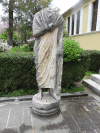
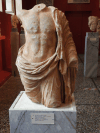
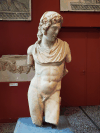
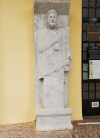



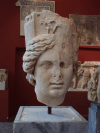
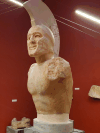
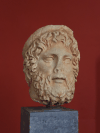

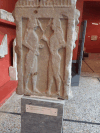
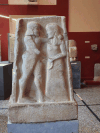
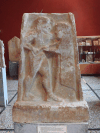



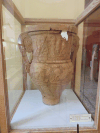

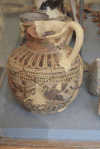
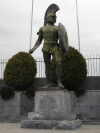
This page contains 29 pictures
Here are the links to the other main pages on Greece:
Page last updated on Mon Aug 15 16:08:12 2022 (Mountain Standard Time)
Sparta on soaring.guenther-eichhorn.com